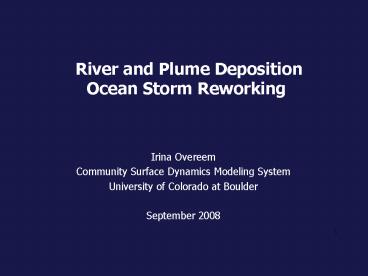River and Plume Deposition Ocean Storm Reworking - PowerPoint PPT Presentation
1 / 26
Title:
River and Plume Deposition Ocean Storm Reworking
Description:
Steady 2D advection-diffusion equation: where: x, y are coordinate directions ... ? is the first-order removal rate constant. Steady 2D advection-diffusion equation: ... – PowerPoint PPT presentation
Number of Views:112
Avg rating:3.0/5.0
Title: River and Plume Deposition Ocean Storm Reworking
1
River and Plume Deposition Ocean Storm Reworking
- Irina Overeem
- Community Surface Dynamics Modeling System
- University of Colorado at Boulder
- September 2008
2
Course outline 1
- Lectures by Irina Overeem
- Introduction and overview
- Deterministic and geometric models
- Sedimentary process models I
- Sedimentary process models II
- Uncertainty in modeling
3
Modeling stratigraphy with process models the
workflow
INPUT
MODEL PROCESSES
OUTPUT
- River Basin data
- Tectonic evolution
- Climate data
- Marine Basin data
- Sea Level data
- Variability of data
- River Deposition
- Delta Plumes
- Barrier Deposition
- Marine Reworking
- Turbidity Currents
- Variability of processes
- Analyze output
- Sensitivity tests
- Comparison real-world data
- Uncertainty analysis
4
Hypopycnal Plume
- Steady 2D advection-diffusion equation
- where x, y are coordinate directions
- u, v are velocities
- K is turbulent sediment diffusivity
- I is sediment inventory
- ? is the first-order removal rate constant
5
- Steady 2D advection-diffusion equation
- where x, y are coordinate directions (m)
- u, v are velocities (m/s)
- K is turbulent sediment diffusivity (m2/s)
- I is sediment inventory (kg/m2)
6
Simple Plume Experiment
- Simple 1000 year 2D SedFlux experiment of 1000
year duration - - generic bathymetric profile (at 80 km, -120m
waterdepth, dropping to 300m) - stable sediment input and water discharge
- slow sea level rise
7
Grain Size dependent deposition
Simple 1000 year 2D SedFlux experiment with
stable sediment input and slow sea level
rise Coarse sediment scenario 1200, 400, 250,
60, 30 micron Fine sediment scenario 400, 150,
60, 5, 2 micron
8
River mouth dependent deposition
Simple 1000 year 2D SedFlux experiment with
stable sediment input and slow sea level rise,
stable total daily discharge Wide River
scenario w0 750m, b01.66m Narrow River
scenario w0 125 m, b0 10m
9
River velocity dependent deposition
Simple 1000 year 2D SedFlux experiment with
stable sediment input and slow sea level rise,
stable total daily discharge Fast Plume
scenario u0 1.2 m/sec Slow Plume scenario u0
0.8 m/sec
10
Plume examples
River Mouth Angle 45 º
River Mouth Angle 15 º
Data courtesy, Kettner and Hutton, CSDMS
11
External factors influencing plumes
Coriolis effect
- The shape that a hypopycnal plume will have,
depends on a variety of factors - Angle between the river course at the entry
point and the coastline. - Strength and direction of the coastal current.
- Wind direction and its influence on local
upwelling or downwelling conditions. - Mixing (tidal or storm) energy near the river
mouth. - Latitude of the river mouth and thus the strength
of the Coriolis effect.
Curved plumes
12
Storm and Wave Erosion
Conceptual design of the storm erosion model,
BARSIM, (Storms et al, 2003). Sediment supply by
longshore drift
13
Ocean Storms from buoy observations
Buoy data leads to pick an exponential function
to fit the storm wave-height distribution for the
sedimentary process model.
14
Ocean Storms from wave models
Wave height in m
WaveWatch III model, predicts 3-hourly global
waves The description of the wave field is done
with the significant wave height average
height of highest 33 of waves. (Tolman, a.o.
2000-2003).
15
Sample storm conditions from real-world wave
height distribution
16
Simulated depositional pattern
Experiment conditions are ? sea level 0
my-1, and sediment supply 0 m2y-1
17
Simulated barrier stratigraphy
scenario ? sea level 0 my-1 and sediment supply
20 m2y-1
18
Shelf slope variability
? sea level 0 sediment supply 20 m2y-1
STEEP
GENTLE
19
Grain Size variability
Water depth in m
COARSE
MEDIUM
FINE
? sea level 0, sediment supply 20 m2y-1
20
Wave height regime variability
? sea level 0 sediment supply 20 m2y-1
21
Model Test what kind of variability can be
expected in the stratigraphic record resulting
from variation in wave-height regime during
deposition?
22
Wave height regime variability sine shaped
? sea level 0 sediment supply 15 m2y-1 dtmin
40y total time 40 ky Whmin 3 m Whmax 5
m Whperiod 10 ky
23
Simulated barrier stratigraphy
24
Summary
- Prediction of inter-well stratigraphy by
process-response modelling is fundamentally
different from geostatistical interpolation
techniques - Numerical models that simulate detailed
sedimentary processes are a tool to experiment
with the different factors controlling the
reservoir-scale geometry (grain size, slope,
river regime, wave regime). - Such models are usually restricted in spatial
scale and represent a single environment
25
References Delta Plumes
- Albertson, M.L., Dai, Y.B., Jensen, R.A., Hunter,
R., 1950, Diffusion of submerged jets. American
Society Civil Engineers Trans, v. 115, p.
639-697. - Bates, C.C., 1953, Rational theory of delta
formation. AAPG Bulletin, v. 37, p. 2119-2162. - Syvitski, J.P.M., Skene, K.I., Nicholson-Murray,
K., Morehead, M., 1998a, PLUME 1.1 deposition
of sediment from a fluvial plume. Computers
Geosciences, v. 24, 2, p. 159-171. - Nemec, W., 1995, The dynamics of deltaic
suspension plumes In Oti, M.N., Postma,
G.(eds.). Geology of deltas, Balkema, Rotterdam,
The Netherlands. p. 31-93. - Overeem, I., Syvitski, J.P.M., Hutton, E.W.H.,
(2005). Three-dimensional numerical modeling of
deltas. SEPM Spec. Issue, 83. River Deltas
concepts, models and examples. p.13-30.
26
References Storm Erosion Models
- Storms et al., 2002. Process-response modeling of
wave-dominated coastal systems simulating
evolution and stratigraphy on geological
timescales. J. Sedimentary Research, 72, 226-239. - Storms, 2003. Event-based stratigraphic
simulation of wave-dominated shallow-marine
environments. Marine Geology 199, 83-100. - Cowell et al,1999. Simulating coastal system
tracts using the shoreface translation model. In
Harbaugh et al, 1999. Numerical Experiments in
Stratigraphy. SEPM Spec. Pub., 62, 165-175.































